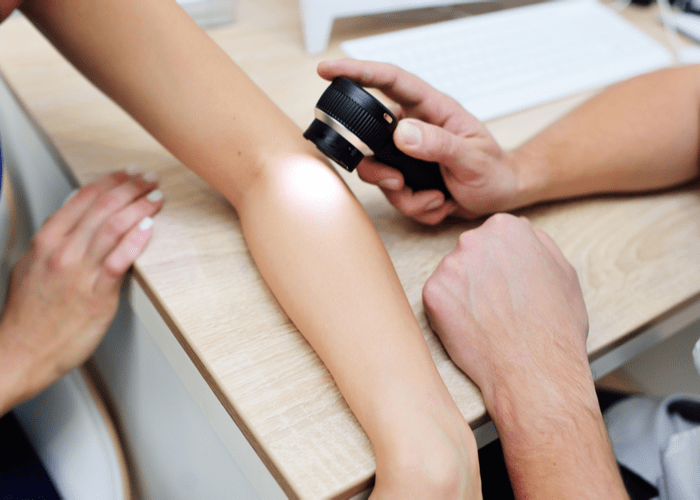
With summer just around the corner, we look at Australia’s most common cancer type and meet three Cure Cancer researchers focused on melanoma.
Melanoma is one of the ten most common cancers in both Australian men and women, with 16,221 people expected to be diagnosed with it in 2020.
The skin is made up of many types of cells and one of these cell types – called melanocytes – gives the skin its colour by producing a brown pigment called melanin. Melanoma is cancer that occurs in these cells.
Other types of skin cells can also develop into cancer, such as squamous cell carcinoma or basal cell carcinoma. These are sometimes called non-melanoma skin cancer, and are more common than melanoma. Melanoma is more likely to spread to other parts of the body than other types of skin cancer and can occur anywhere on the skin, but it is more common on the body, head or neck in men; and the arms and legs in women.
Cure Cancer has supported many melanoma research projects, including the work of Dr Esther Lim (Macquarie University), Dr Kelly Brooks (QIMR Berghofer Medical Research Institute) and Dr Lauren Aoude (University of Queensland Diamantina Institute).
Dr Esther Lim
Esther’s research looks for ways to boost the human immune system to improve the effectiveness of current melanoma therapies. Specifically, she investigates inhibitors for a protein pathway in the body known as MAPK, which plays a key role in the development of melanoma.
Work in this field has already improved survival rates of the 30-40% of Australian patients who have a form of the disease known as BRAF-mutant melanoma. ‘Outcomes of this project will translate rapidly into clinical practice, and will hopefully help improve patients’ lives,’ she says.
Esther believes that the biggest challenge for cancer medicine is that there’s so much research and work to be done, and never enough funding to support it in the way that it deserves. ‘That’s why the Cure Cancer grants are so important; they foster the progress of understanding a very difficult disease and the discovery of new treatments,’ she says.
To cancer patients and their families, Esther has a message of hope: ‘We’ve made significant leaps in understanding this disease and all cancer researchers, including myself, are working very hard towards finding better treatments and, ultimately, a cure.’
Dr Kelly Brooks
Kelly studies uveal melanoma, or melanoma of the eye. Uveal melanoma is a rarer melanoma subtype, but patient outcomes are worse than that for the more common skin-based melanoma. ‘In approximately 50% of uveal melanoma patients, the cancer will spread to other sites in the body and currently there are no effective systemic treatments available for this,’ says Kelly.
The work Kelly is doing is focused on understanding a signalling pathway that is defective in over 90% of uveal melanomas. As such, understanding and being able to target these signalling defects has the potential to provide treatment options for many uveal melanoma patients, and for other cancers that demonstrate abnormal signalling in this pathway.
For Kelly, her Cure Cancer grant provides recognition of the importance of understanding this rare but significant melanoma subtype. ‘Rarer cancer subtypes are becoming more of a priority world-wide, and the award of this grant provides me with the stepping stone I need to establish myself as a uveal melanoma researcher in Australia.’
‘Personally, I feel extremely grateful for the award of this grant as it allows me to pursue a career I am passionate about. Being personally touched by cancer through family members, this work is about more than a career to me and this funding provides me with the means to keep striving towards my ultimate goal of making a tangible impact on this devastating disease.’
Dr Lauren Aoude
Lauren is a researcher in the Surgical Oncology Group at the University of Queensland Diamantina Institute . An NHMRC Early Career Fellow with over 10 years’ experience in the field of melanoma biology, she has also completed a PhD in melanoma genetics at the University of Queensland in 2014. During her PhD, Lauren was involved in the whole-genome/exome sequencing of over 250 melanoma families.
Lauren’s research sees her investigating the genomics that drive melanoma tumours. Her current work combines exome sequencing data from melanoma patients with PET/CT scans with the aim of improving the way in which patients are treated in the clinic. This project combines deep whole-exome sequencing of tumours with routine PET/CT imaging to confirm an association between clinical presentation, tumour genomic data and PET/CT scans in melanoma patients.
‘The Cure Cancer grant is vitally important to my work, and without it this research could not be done,’ says Lauren. ‘It gives me the means as a young investigator to run my own project and become a more independent researcher. The grant has given me the opportunity to run a project as a lead investigator. I aspire to run my own lab one day and to have the research support of a major funding body is very exciting. Personally, I am thrilled to undertake this project because I believe it is an important body of work that could change the way in which melanoma patients are treated in the future.’
Without the generosity of donors, the work of Esther, Kelly and Lauren would not be possible. Please consider making a donation today to help Cure Cancer’s research continue their life saving research.
Resource: